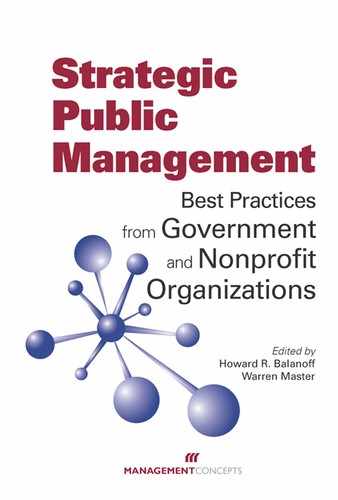Contents
PART 1 Strategic Program Operations.
CHAPTER 1 Planning and Managing Core Mission Functions at the Municipal Level
Distinguishing Among Wicked Problems
Failure to Conceptualize Externally
Small Problems and Conceptualization
Managers’ Capacity to Implement Solutions
CHAPTER 2 Planning and Managing Core Mission Functions in San Diego County, California
The Discipline of a General Management System
A Complex Health and Human Services Agency Grapples with Strategic Alignment
All Hands Engaged in Priority Food Stamps Initiative
Reengineering the Eligibility System
The Third Dimension: Engaging Citizens and Stakeholders
CHAPTER 3 Planning and Resource Decision-Making at the Federal Level
The Conundrum of Measuring Public Sector Productivity
Understanding Management Behavior in Federal Environments
PART 2 Strategic Budget and Financial Management
CHAPTER 4 Managing Risk in the Federal Fiscal Environment
Risk Management in the National Security Arena
Common Errors in Risk Management
Obtaining Accurate Intelligence
Measuring Risk and Performance
CHAPTER 6 Managing a Governmental Health Plan
PART 3 Strategic Human Capital Management
CHAPTER 7 A Road Map for Federal Strategic Human Capital Planning
Successful Strategic HC Planning
Make Leaders Accountable for Results
Create a Clear Set of Planning Steps
CHAPTER 8 Fostering Professional Development through Certified Public Manager Programs
National Certified Public Manager Consortium
ASPA’s Section on Certified Public Management
Emphasis on Public-Sector Ethics and Integrity
CHAPTER 9 Fostering Ethics and Accountability in the Public-Sector Workplace
Accountability and the Subcomponents of Morals: Ethics, Values, and Principles
Subjective Standards vs. Objective Standards
Decision-Making on Ethical and Moral Issues
CHAPTER 11 Maximizing Public Organization Talent Strategically and Systemically
Eight Recommended Strategies and Tactics
Lessons from the Economic Crisis
Results of the 2008 Federal Human Capital Survey
The Nuclear Regulatory Commission Ranks First in the Best Places to Work in the Federal Government
PART 4 Strategic Knowledge and Technology Management
CHAPTER 12 Technology Challenges for 21st-century Government
Technology Trends: Longer Term
CHAPTER 13 Webcentricity and Five Challenges for Public Management
Transparency and Citizen Engagement
Web 2.0 to 3.0: The Social Networking Phenomenon
Governmental Social Networking Sites
The Dangers of Social Viral Media
CHAPTER 14 Web 2.0’s Knowledge Management Potential in the Public Sector
Capturing Tacit Knowledge through Web 2.0
Considerations for Implementing a Web 2.0 Strategy
Resetting Expectations about Knowledge Management
Clarifying Decision-Making Authority
Ensuring Adequate Stakeholder Representation
Determining How to Accredit Expertise
PART 5 Strategic Acquisition Management
CHAPTER 15 Contracting for Services in State and Local Government
Elements of Government Contracting
Solicitation and Selection of Contractors
Contract Administration and the Government’s Relationship with the Contractor
Evaluation of Contractor Performance
Using Contractor Performance Information to Make Decisions
PART 6 Strategic Performance Management
CHAPTER 16 Citistat: Evaluating City Management in Baltimore, Maryland
CHAPTER 17 Comparing Local Performance Management in the United Kingdom and United States
Nurturing a Performance Culture
Creating a Holistic Performance Management Framework
Aligning Resources and Activities with Corporate Goals
Benchmarking against Similar Profile Organizations
Performance Reporting to Citizens
Tracking Performance in Partnerships
Using Software to Support the Performance Management Process
